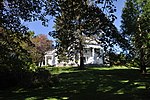Smithfield Presbyterian Church (Amenia, New York)

Smithfield Presbyterian Church is a historic Presbyterian church located near Amenia, Dutchess County, New York. It was built about 1847–1848, and is a one-story, Greek Revival style heavy timber frame church sheathed in clapboard. It has a stone foundation and gable roof and features a tetrastyle portico supported by four Ionic order columns. The church was refurbished in 1938. Also on the property is a contributing horse shed, Sexton's House (1857), and church cemetery, with the earliest grave dated to 1737. George Whitefield (1714-1770) preached an open air revival sermon at the church in June 1770.: 3–4, 6 It was added to the National Register of Historic Places in 2012.
Excerpt from the Wikipedia article Smithfield Presbyterian Church (Amenia, New York) (License: CC BY-SA 3.0, Authors, Images).Smithfield Presbyterian Church (Amenia, New York)
Sn Fri Road, Town of North East
Geographical coordinates (GPS) Address Nearby Places Show on map
Geographical coordinates (GPS)
| Latitude | Longitude |
|---|---|
| N 41.885833333333 ° | E -73.6 ° |
Address
Sn Fri Road 400
12501 Town of North East
New York, United States
Open on Google Maps




